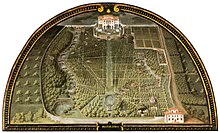TheVilla di Pratolinowas a Renaissance patrician villa inVaglia,Tuscany,Italy.It was mostly demolished in 1822. Its remains are now part of the Villa Demidoff, 12 km north ofFlorence,reached from the main road toBologna.

History
editThe villa was built byFrancesco de' Medici, Grand Duke of Tuscany,in part to please his Venetian mistress, the celebratedBianca Cappello.Villa and gardens were designed by his court architect, designer and engineerBernardo Buontalenti,who completed the construction from 1569 to 1581. It was sufficiently finished to provide the setting for Francesco's public wedding to Bianca Cappello in 1579. In its time it was a splendid example of theMannerist garden.
Francesco had assembled most of the property, which was not a hereditaryMedicipossession, by September 1568,[1]and construction began the following spring.
The garden was laid out along a perfectly straight down-slope axis passing through the center of the villa, which stood midway. Down the central descent, the visitor still walks under a cooling arch of fountain jets, without getting wet.
Michel de Montaigne,one of the earliest visitors to leave a description of Pratolino, saw it in 1581,[2]and considered it to have been built, he thought when visitingVilla d'Este,"precisely in rivalry with this place". A long description was published by a Florentine,Francesco de' Vieri,in 1586.[3][4]Giusto Utensincluded a view of the southern half of the villa and its gardens[4]among his series of lunettes containing bird's-eye views of the Medicean villas painted in 1599.Stefano Della Bellamade six etchings of the Pratolino's gardens in the mid-17th century,[4]the picture is rounded out by further 18th century descriptions. Nevertheless, Pratolino has not survived, as otherMedici villashave.
Though the villa and its fountains were kept in repair, after Francesco's death it was deserted. The Pratolino appeared to be closely designed to please the original owner and in later periods many of its features were seen as too expensive to maintain.[5]In 1773, some of its sculptures were removed to adorn the extension of theBoboli Gardensand the place was left to fall into decay;[5]by 1798 a German visitor was impressed with the romantic ruin of it.[6]Grand DukeFerdinand IIIdecided to capitalize on the air of overgrown wildness; in 1820 it was decided to demolish the villa, and the garden was then re-designed in theEnglish landscape mannerand became one of the most romantic gardens ever seen in Tuscany. In 1872 the complex was sold by the heirs ofLeopold II, former Grand Duke of Tuscany,to PrincePavel Pavlovich Demidovwho restored thePaggeria,or pages' lodgings of the former residence, as the Villa Demidoff di Pratolino. The property was eventually inherited byPrince Paul of Yugoslavia.Later the park was bought by the province of Florence who maintain the park and open it for public use from April through October.
The complicated iconography of the garden is embodied in the brooding statue of "Appennino",a colossal sculpture byGiambologna[7]built in 1579–1580, which originally seemed to emerge from the vaulted rockwork niche that once surrounded him. Multiplegrottoeswith water-drivenautomata,awater organ,surprise jets that drenched visitors' finery when thefontanieriopened secret spigots,[8]offered striking juxtapositions of Art with imitations of rugged Nature.
See also
editReferences
edit- ^Most of the factual information in this article is derived from Webster Smith, "Pratolino"The Journal of the Society of Architectural Historians20.4 (December 1961), pp. 155-168; Smith derived his documentary information from the Florentine State Archives.
- ^Montaigne,Journal de voyage en Italie par la Suisse et l'Allemagne en 1580 et 1581.
- ^de' Vieri,Delle marauigliose opere di Pratolino;Vieri had the cooperation of Buontalenti and his son Francesco Buontalenti in setting out the plans on paper.
- ^abcSmith, Webster (1961)."Pratolino".Journal of the Society of Architectural Historians.20(4): 155–168.doi:10.2307/988039.ISSN0037-9808.JSTOR988039.
- ^abCresti, Carlo (1994).Villas of Tuscany.Cassell. pp. 219–222.ISBN0304344877.
- ^Ernst Moritz Arndt, noted in Smith 1961:166.
- ^Steadman, Philip (2021),p.290
- ^Steadman, Philip (2021),"The 'garden of marvels' at Pratolino",Renaissance Fun,The machines behind the scenes, UCL Press, pp. 287–289,doi:10.2307/j.ctv18msqmt.16,ISBN978-1-78735-916-1,JSTORj.ctv18msqmt.16,S2CID241909486,retrieved2022-01-16